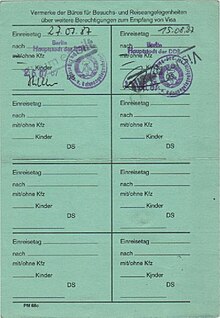Certificate of authorization to receive a GDR visa
The authorization certificate to receive a GDR visa was the prerequisite for visits and trips by persons with permanent residence in Berlin (West) to enter the capital of the GDR ( East Berlin ) or the GDR itself (italics: original text GDR). For West Germans ( citizens of the FRG ) and foreigners, entry with a valid passport was immediately possible after a visa was issued at the border crossing point, but only for the urban area of East Berlin.
For entry from West Germany into the GDR - for example in border traffic on the inner German border - different regulations were applied. Here, too, there were differences between West Berliners and people from the FRG (from West Germany ), since the GDR authorities did not recognize federal passports of West Berliners. West Berliners could only travel in the entire Eastern Bloc with the "makeshift Berlin ID card ".
Requirement and grant

Since 1972 (supplementary agreement to the four-power agreement ), authorization certificates have been issued upon application against presentation of the “makeshift Berlin identity card”. To this end, five “ Offices for Visiting and Travel Matters ” (BfBR) were set up in West Berlin .
The authorizations for West Berliners were issued for a single day visa or as a multiple authorization certificate for a maximum of nine visas each . The green, postcard-sized multiple authorization certificates with personal data printed on the front for issuing the first visa had eight small fields on the back for applying for additional visas. They were valid for three months from the date of issue and entitle the holder to receive the visa at the border crossing points . The same transition had to be used for entry and exit for day visits. Even with multiple authorization certificates, a visit to one of the offices was necessary beforehand, the entry permit was then issued immediately after entering the travel date. You had to leave the country by midnight (from July 1982 until 2:00 a.m. the following day). Stays lasting several days were only possible after a special visa was issued, which was required by an invitation from the GDR. However, it was possible to re-enter shortly after midnight immediately after leaving the country, if one had also obtained a corresponding entry on the authorization certificate for the following day. In May 1988 a 48-hour visa was introduced, which was only valid for the area of East Berlin. With this visa, departure had to take place by midnight the following day, so that an overnight stay in East Berlin was possible. Since then, different border crossing points have been used for entry and exit. A registration at the Volkspolizei- Kreisamt or the Volkspolizei-Inspection, which had to be done within 24 hours for foreigners, was not necessary when entering with a 48-hour visa. However, the visitor had to be entered in the house book of the HGL (house community management) of his host .
In addition to the presentation of ID, it was necessary to state the border crossing point and the purpose of the trip: visiting relatives, acquaintances or “for tourist reasons”. The authorization was granted for a visa to East Berlin ( Berlin - capital of the GDR ) or for the entire GDR. Entry was limited to 30 days a year. After two to three days, the authorization could then be picked up or sent by post; in special cases, entry was also possible on the same day. The documents for a single entry consisted of an entry and exit card and a form for the declaration of foreign currency and objects.
When the ninth visa was issued, the multiple authorization certificate was regularly withdrawn at the respective border crossing point. Therefore, in private ownership, there are only those multiple authorization certificates with nine visa applications where the holder had let the last one expire. On the front and back there were facsimile stamped signatures of "Franzke" or "Wesser", which is why these authorization certificates were also called "Wesserscheine" in insider circles.
The “Offices for Visiting and Travel Matters” in West Berlin
Working group XVII - Office for Visiting and Travel Matters (BfBR) in Berlin (West) of the Ministry for State Security (MfS) was responsible for examining a visa application and issuing the so-called entry and exit card . This had five offices in West Berlin for visiting and travel matters .
The offices were located in the following West Berlin districts:
- Charlottenburg , then address: 1000 Berlin 12, Jebensstrasse 1 (at the Bahnhof Zoo )
- Steglitz , 1000 Berlin 41, Schloßstraße 1 (in Forum Steglitz )
- Kreuzberg , 1000 Berlin 61, Waterloo-Ufer 5-7
- Wedding , 1000 Berlin 65, Schulstrasse 118
- Spandau , 1000 Berlin 20, Reformationsplatz 5
See also
- Travel restrictions
- Pass Agreement
- Travel formalities at the inner-German border
- Regulations for traffic close to the border (so-called small border traffic on the inner-German border from October 1972)
Web links
- Temporary enactment ... Regulation of the Council of Ministers of the GDR
- Visa forms and attachments
Individual evidence
- ↑ Source: The Stasi in West Berlin , ARD documentation by Ute Bönnen and Gerald Endres, RBB 2010



